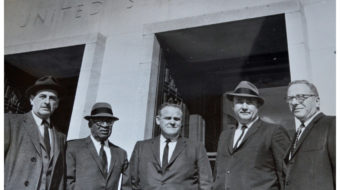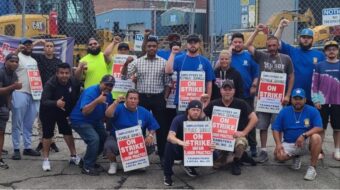Braddock, Pa. – On Friday, I and three other labor journalists paid a visit to the mayor of a town some folks in the Monongahela Valley call “Hell.”
Braddock is the poorest town in Allegheny County and John Fetterman, 39, its chief executive, presents himself quite differently than do most mayors. Among the first things that strike you about this young white mayor of a largely African American town are his 380 lbs., six foot and eight inches of height, his bald head, and the town’s zip code tattooed onto one of his enormous arms.
Knowing that he had an MBA from the University of Connecticut made the first moments of our encounter even more jaw dropping. The setting he arranged for our meeting – the space between an abandoned storefront on one side and an empty lot serving as a garbage dump on the other- was also a bit unusual. Three young men, two Black and one white, were cleaning up debris in and around the storefront. A young white woman dressed in a goth style black skirt and knee high boots worked with a young African American woman digging up and turning over soil in a section of the lot that had been cleared of debris.
The mayor started talking right away about how pleased he was with the decreasing homicide rate in Braddock. “Prior to this year a person or two was killed here every six months,” he said. “No one has died here this year.”
For those of us who live in huge cities a murder rate like that doesn’t seem, at first, to be so bad.
Braddock, however, once home for 20,000 people, has only 2,800 folks living there today.
Once an envied example of what U.S. industrial prowess could do for the lifestyle of workers, Braddock’s main street is now a stretch of boarded up storefronts and crumbling houses, lots filled with garbage, and ghosts of warehouses and factories that stopped humming long ago.
While the mayor took a moment to talk with the young men at the storefront, I spoke to the young woman in the goth style skirt. She said that all the way down at the end of the street was the first steel mill founded by Andrew Carnegie and owned now by U.S. Steel. A block and a half away, in the other direction, she said, was the only store in town where you could buy something – the Family Dollar Store.
She said the mill, which continues to operate today, belches out a sooty black haze that often settles on surfaces all over town. “It doesn’t show up on my dark clothes,” she said.
The 700 workers at the mill produce 3 million tons of steel a year – about 15 percent of the total domestic output of steel in America. “The problem is that none of the workers live here in Braddock,” the young woman said. “They hightail it out of here as soon as their shifts are over.”
Mayor Fetterman explained that Braddock’s descent into Hell parallels the de-industrialization of America.
For a century, Pennsylvania’s Monongahela Valley was the place where factories made the steel that became the building blocks of America. And it was the place where workers in struggle built a vibrant labor movement that spread across the entire nation.
Today the poverty rate in Braddock is three times the national average with half the town on public assistance and a murder rate, up until a few months ago that was at least six times the national average.
While you can purchase a house in Detroit, on average, for $19,000 in Braddock homes go, if they go at all, for $6000.
Shannon Gustafson, 30, was walking along the town’s Main Street when I spotted her. She and her “starving artist” husband moved to Braddock in November of 2008 from Chicago’s Rogers Park neighborhood where the couple found it difficult to pay their “ever increasing” rent and where the cost of purchasing a home was “just way out of reach.” She had read about what was going on in Braddock on the internet and responded to an invitation from Fetterman to “visit” the place. As she tells it, “We were hooked about the idea of moving here and becoming urban pioneers. So we bought a house for $4,500 from a senior citizen who was leaving to move in with her family.”
Gustafson works with AmeriCorps (often referred to as “the domestic Peace Corps”), coordinating youth activities including the clearing of lots and dilapidated buildings and the planting of organic farms in the midst of the urban blight. Her husband too is very involved in helping the effort to build a new Braddock. He is refurbishing the house they bought and conducts a small, still struggling art business on the internet. “We see building a new Braddock for the people who live here and for the many more who will come in the future. This is not about gentrification. You have to believe in our dream if you come here and want to stay because you couldn’t turn around a property for a profit here even if you were the cleverest real estate dealer. This is about re-claiming and even increasing the resources that inner city life can offer to ordinary people but, the way things are now, it will take a long time.”
Gustafson said she was pleased that through AmeriCorps the town was able to hire 100 young people for the clearing and planting effort this summer. “The president’s economic stimulus program made some of that possible because, without the stimulus, we would have only been able to hire 70. That’s 100 youth we were able to get off the streets. Doing the equivalent in a big city like Pittsburgh would take 10,000 off the streets. This is why the sale and use of crack is going down in Braddock and this is why the level of street violence is finally going down.”
Gustafson said a couple from Alaska just bought house down the street from her. “They came pretty much for the same reasons we came except perhaps with the extra motivation of having found a good way to get away from all the Sarah Palin stuff.” So far there are about a dozen other urban pioneer families in town, from places like Kansas City, St. Louis and Brooklyn.
Braddock has unemployed African American and white steelworkers, minimum wage workers who earn their living as security guards and store clerks on strip malls, single mothers on public assistance, many unemployed young people, and now the homesteaders, often called “the artists,” by their neighbors. I asked Shannon Gustafson about how well the various groups living in town were able to work together.
“People here are united around an idea that is really exciting,” she said, “and almost everyone feels deep inside that we will all rise or we will all go down together.”
Later, when I went into the Family Dollar store to buy a can of soda the African American woman at the register answered the same question. “Look around. We’re all in the same boat here, it don’t matter how you got here or where you came from. Mayor John understands this better than any politician I ever met. We are trying to make things work around here and I don’t really know if they will, but we try. I’ll go down trying. Things can only go up from here.”
We talked to Mayor Fetterman about de-industrialization and the ensuing destruction of the workingclass economic base in the Mon Valley
He said Braddock was a poster child for what can happen when you don’t have a vibrant well paid working class, able to purchase a variety of goods and services and warned that many more Braddocks could be in America’s future if the foreclosures continue and things are not turned around. He lists additional massive stimulus programs, reform of health care and expanding the size and strength of the ranks of organized labor as high priorities in the longer term struggle.
Fetterman, himself, does not have health care coverage and his wife gave birth to their first child earlier this year at home in the loft apartment they have in an abandoned church they purchased.
“Look at Braddock to see what happens when you destroy the labor movement,” he said. Surveying and pointing to the damage along his town’s main street, he ticked off some figures. “We had 13 thriving furniture stores along here, now we have none. There were 15 jewelry stores, now we have none. There were 45 bars and now we have none. All that has dwindled to a pawn shop and the Dollar Store.”
Fetterman was actually the first of the urban pioneers to come to Braddock.
The son of an insurance company executive, he grew up in York, Pa. After he earned his MBA he spent 15 months working for his father’s company but, at the age of 25, had what he calls his “quarter life crisis.”
He went to work for AmeriCorps when it was a new program initiated under President Bill Clinton. His job was finding jobs for homeless youth in Pittsburgh.
In 2001 he moved to Braddock because, he said, “there was more opportunity to do what I was doing. It was Pittsburgh times 100.”
Once in Braddock, he began to register all the youth he worked with to vote and won a one vote victory in a three-way race for mayor.
Four years later he won in a landslide.
He smiled proudly as he watched the young people cleaning up the storefront and their colleagues turning over the soil in the urban garden-to-be. “Most of these folks are the only members of their families currently employed,” he said. “Do you know what that means to them?”
Fetterman believes that a major WPA type program will be needed to help create the kinds of jobs that will sustain life in the Mon Valley over the long term.
He thinks the efforts of the Steelworkers and other unions involved in a major push to build a magnetic levitation rail system in Pennsylvania are also important because “they can create the needed green industrial jobs that are so critical if this country is to have any kind of future at all.”
We labor journalists left Braddock with some important lessons.
First was the obvious. There is no future for this great country of ours without a vibrant working class leading the way. Health care, Employee Free Choice and a massive second stimulus program are critical first steps in that direction.
But we left with another, perhaps more important realization, and with a feeling of pride. When you look at what they are doing in Braddock you can’t tell for sure how it will all turn out. But what you can say for sure is that this multi-racial, multi-national American working class of ours’ is the most productive, resilient, determined, and imaginative bunch of people in history. We have a lot to be proud of.
John Wojcik is labor editor of the People’s Weekly World newspaper. The visit to Braddock was organized by International Labor Communications Association (ILCA) as park of their 2009 Convention.










